In this lesson, you’ll find the first 5 songs that I like to teach my guitar students to teach them power chords.
Power chords are used in many styles of music, but you’ll find them mostly in rock music. They sound great on an electric guitar with some distortion, but can also sound good on an acoustic if they are played with some confidence.
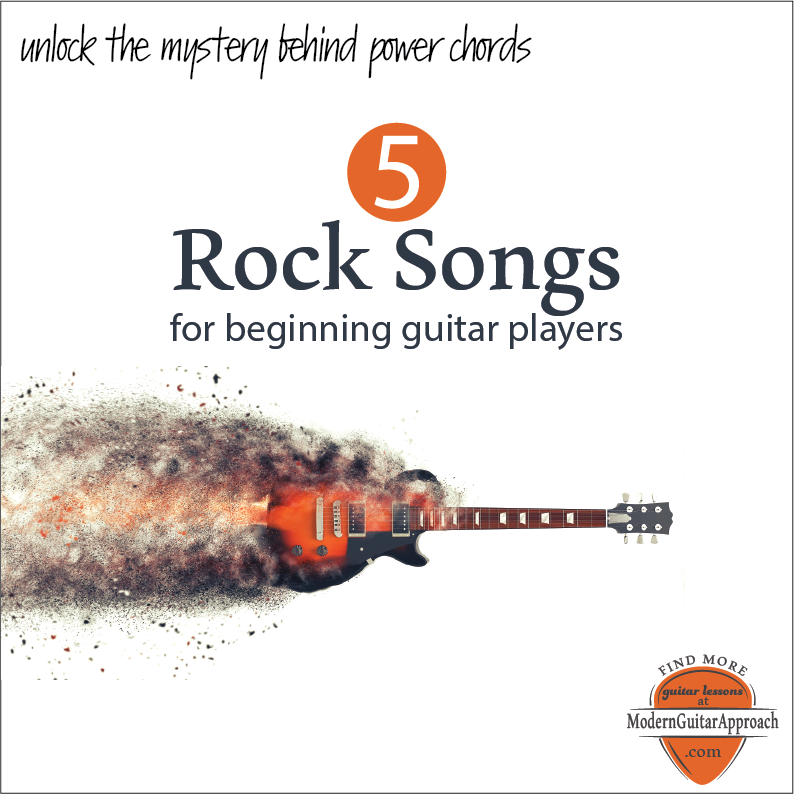
What Is A Power Chord?
A power chord is a two-note chord, with no major or minor quality to it. This is because power chords are just made up of the root and the fifth of the chord. Power chords use the number 5 to indicate that it’s a power chord because that is the only other note that you’re playing besides the root of the chord.
You can either play a two string power chord, or a three string power chord. When playing a two string power chord, your lowest string plays the root, and the next string plays the 5th. For example, if you were to play a B5, your first finger would play the B note and your third finger would play the 5th (which is F#).
If you were to play a 3 string power chord, the highest string just repeats the root chord. This means that if you were playing a B5, you would simply play another B note. Below is a graphic that helps explain this concept.
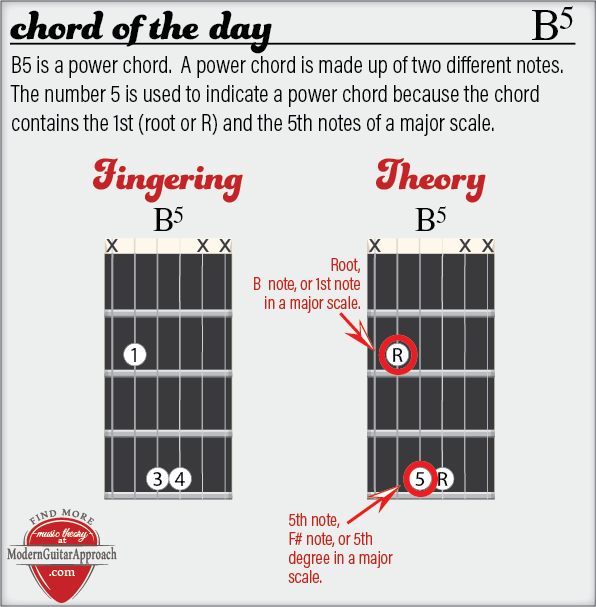
Learning Your Note Names
I LOVE teaching power chords! It is the easiest way to get my students to learn the names of their notes on the 6th and 5th strings! For example, if you want to play a C5, you need to know where C is on either the 5th or 6th string.
There are many great rock songs written out in guitar tablature, but I don’t use those in the beginning, because they won’t teach the concept as well. When you only use tablature for power chords, you never really learn the concept behind what you’re playing.
6th String Power Chords
Let’s start by looking at power chords played on the 6th string. To be able to play a power chord on the 6th string, you first need to know the names of the notes on each fret. Below is a picture of the note names on the 6th string. The image also shows what a two string and three string power chord both look like.

1. Glycerine by Bush
You’ll notice that there is also a song that you can try… Glycerine, by Bush. I also have the full song below. This song uses 4 power chords that can all be found on the 6th string. The chords are:
- F5, on the 1st fret
- C5, on the 8th fret
- D5, on the 10th fret
- Bb5, on the 6th fret (one fret lower that B)
Beginners will have better luck playing this song with two string power chords. Once that feels easier, try playing with a 3 string chord.
Strumming with all downs on eighth notes
If you look at the strum pattern, you’ll see that all of the eighth notes are strummed down. Although this isn’t always the case with power chords, it is very common. Power chords just sound better when they are all strummed down. Save the upstrums for the 16th notes that almost always show up in rock songs. You’ll notice that even this song has some 16th notes at the end.
Accent
An accent means to emphasize a note or strum. You do this by playing it louder than the other notes surrounding it. This song uses a syncopated strum pattern. It sounds this way through using an accent. When starting this song, first get it down without the accent. Once you are comfortable with the chord changes, try adding the accent in. It sounds quite a bit better with the accent.
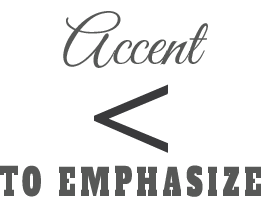

Over Your Head? If this music seems a little too difficult for your abilities, no worries! I have you covered. Be sure to check out some of my lessons for the more beginner guitar player. Once you are comfortable with some of those, be sure to head back over to this page.
- The first seven songs I teach all of my beginning guitar students
- Songs using G, C & D7
- Learning by color
- easy songs using minor chords
5th String Power Chords
Below is an image that shows the names of the notes on the fifth string. It also shows what a two string and three string power chord look like when played on the fifth string.
I’ve also included some great riffs that work well on the 5th string. Iron Man by Black Sabbath, and Cocaine by Eric Clapton. Since I sometimes give this sheet to kids, I was sure to put in parenthesis (don’t do) cocaine :).

2. All The Small Things – Blink 182
This song combines power chords on both the 5th and 6th strings. For example, sometimes they play F5 on the 6th string, and sometimes they play the higher sounding F5 on the 5th string. I have indicated with string to play each chord on for this song to help make the learning process easier.
This song also uses octaves on the 5th string for a guitar solo. An octave is just two roots (the same note) played without including the 5th. Below is what an octave looks like. To make this sound good, I usually lay my first finger lightly over the 4th string to “deaden” it. That way when I strum, it doesn’t make a sound.
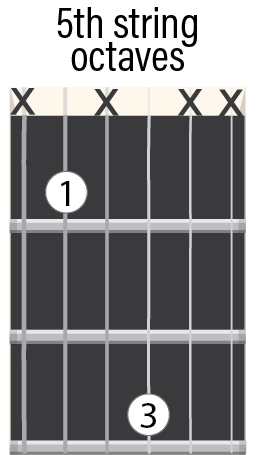
All The Small Things also uses a Palm Mute for the verses. The most common way to play with palm muting is to place the edge of your picking hand (usually right) near the bridge. Then press the fleshy part of your palm down on the strings and strum normally. Your notes should still right through, but now with a more percussive, muted sound.
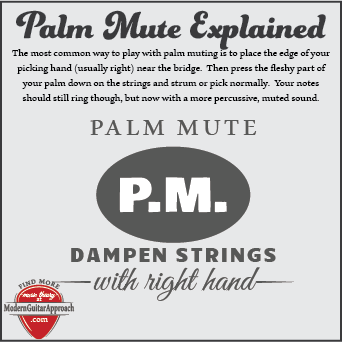

3. Paranoid by Black Sabbath
I also play in a rock band called the Mothers of Mayhem. It is made up of all moms that live in my community. We mostly play hard rock from bands like Black Sabbath, Guns N’ Roses, Metallica and the like (playing in a band with moms is a lot more fun than Bunko night or Book Club). We play most of the songs that I have put in this post. Below is a link to us playing Paranoid by Black Sabbath. Notice that we threw in a nod to Iron Man at the end of my guitar solo.
Since this song has some pretty specific riffs, I wrote this song using a mix of tablature and chords because I still want my students figuring out where these chords are on the fretboard.
This song is also written out with a little less hand holding than the others. For example, to play an E5, you’ll need to refer to the note names toward the top of the post as they aren’t indicated on the song.

4. Song 2 by Blur
What kind of a name is Song 2 anyway? No matter that, this song is super fun to play. The power chords start clean and then move to distortion. This is a great way to learn how to make that switch yourself as switching between clean and distorted sounds while playing a song takes some practice.
This songs intro is all done on the 5th string. To play the chords A5, B5 and C5 to match the song, you’ll need to play them higher on the fretboard as follows:
- A5 = 12th fret
- B5 = 14th fret
- C#5 = 16th fret
There is a pattern in the notes found on the fretboard and the pattern repeats itself starting on the 12th fret. For example, the 5th string open is A and so is the 5th string 12th fret. From there, the notes repeat themselves using the same intervals as on the the lower frets.

5. Your Mama Don’t Dance
This song is a real change up in style from the other songs. This song teaches how to play open power chords accompanied by a riff. I wrote this out using all tablature.
The riff in this song is repeated in using the same intervals, just on different strings. The use a lot of slurs. A slur is a hammer-on or a pull-off. If you’re looking for a great exercise for slurs, check out my guitar lesson easy warm ups. There you will find one on slurs.

